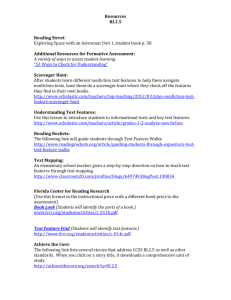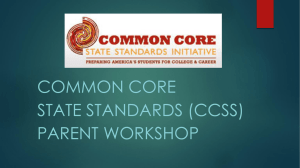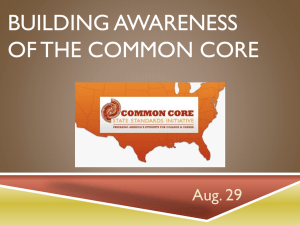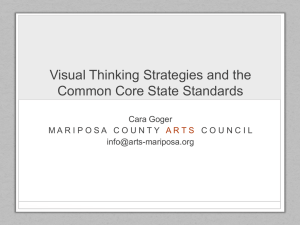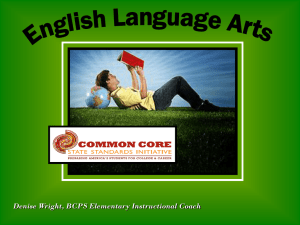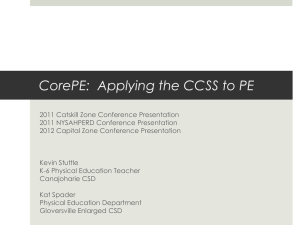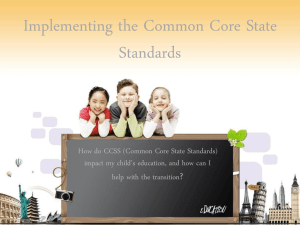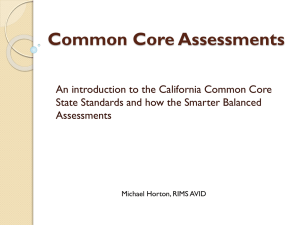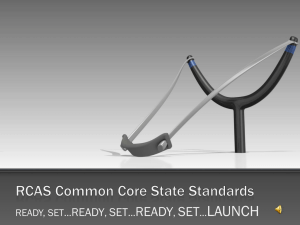The Common Core State Standards
advertisement
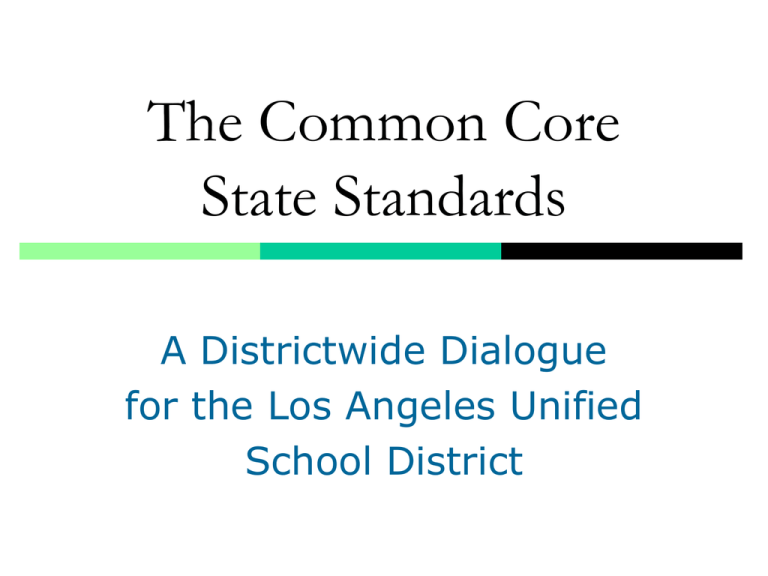
The Common Core State Standards A Districtwide Dialogue for the Los Angeles Unified School District Common Core State Standards What do you know about the Common Core State Standards? Why do you think the CCSS were developed? Common Core State Standards The CCSS are a critical element in bringing about real and meaningful transformation of our national educational system to benefit each student in every classroom. The CCSS help define the knowledge and skills all students need to succeed in college and careers. Expectations will be consistent for all students across the nation. The Development A state-led movement through the National Governors Association and the Council of Chief State School Officers Designed by a diverse group of teachers, professionals, organizations, parents, and school administrators to provide a clear and consistent framework to prepare our children for college and the workforce. The CCSS do not provide: A complete scope and sequence A course outline, or All the essential skills and knowledge students could have The CCSS do provide: Outline the most important essential skills and knowledge every student needs to master to succeed in college and careers. ENGLISH LANGUAGE ARTS and LITERACY IN HISTORY/SOCIAL STUDIES, SCIENCE, AND TECHNICAL SUBJECT STANDARDS The Structure The standards are comprised of a set of Anchor Standards that are the same across K-12 and organized around four strands: •Reading •Writing •Listening & Speaking •Language Foundational Skills There are Grade K-5 Foundational Skills reading standards included in the Common Core State Standards (print concepts, phonological awareness, phonics and word recognition, fluency) Anchor Standards—K-12 Strand Reading: Writing: Listening/ Speaking: Language: Anchor Standards per Strand 10 Anchor Standards 6 Anchor Standards Sample ELA Anchor Standard “Read closely to determine what the text says explicitly to make logical inferences from it; cite specific textual evidence when writing or speaking to support conclusions drawn from the text.” th Kindergarten: “With prompting and support, the student will ask and answer questions about key details in a text.” 11-12 Grade: “Cite strong and thorough textual evidence to support analysis of what the text says explicitly as well as inferences drawn from the text, including determining where the text leaves matters uncertain.” Anchor Standards in History/Social Studies, Science, and Technical Subjects The same Anchor Standards apply to the content areas. History/Social Studies, Science, and Technical Subjects will be taught through the lens of literacy. Sample History/Social Studies Reading Anchor Standard (same as ELA) “Read closely to determine what the text says explicitly to make logical inferences from it; cite specific textual evidence when writing or speaking to support conclusions drawn from the text.” History/SS Grades 6-8: “Cite specific textual evidence to support analysis of primary and secondary sources.” History/SS Grades 11-12: “Cite specific textual evidence to support analysis of primary and secondary sources, connecting insights gained from specific details to an understanding of the text as a whole.” The CCSS and Instructional Shifts The instructional shifts comprise the philosophy that underlies the purpose of the common core state standards These shifts are needed to assist teachers in designing and delivering instruction that will help students think more analytically and gain a deeper understanding of the material. The Shifts in English Language Arts High-Quality Text –Dependent Questions and Tasks •Among the highest priorities of the Common Core State Standards, is that students be able to read closely and gain knowledge from texts. The Shifts in English Language Arts Text Complexity • The Common Core State Standards require students to read increasingly complex text with increasing independence as they progress toward career and college readiness The Shifts in English Language Arts Building Knowledge through Content-Rich Non-fiction and Informational Texts • The standards address reading, and writing across the curriculum that complement the content the standards in history/social studies, science, and technical subjects, thus offering new grounding in informational text, and building knowledge from that reading. Assessments for Accountability The Department of Education articulated the need for a comprehensive assessment system grounded in the following basic principles: Assessments are common across states and aligned to the CCSS Student take “performance-based” assessments Reporting systems will drive decision-making The new assessment system will replace NCLB mandated assessments in participating states. Assessments for Accountability Two National Assessment Consortia PARCC- Partnership for the Assessment of Readiness for College and Careers “Distributed” approach to assessment—“Through Course” Summative score in ELA and Mathematics at end of year Grades 3-11 SMARTER-Smarter Balanced Assessment Consortium “Balanced” approach to assessment—optional interim assessments Summative score in ELA and Mathematics at end of year Grades 3-8 and 11 California is part of the SMARTER Balanced Consortia Common Core State Standards For more information: California CCSS for ELAhttp://www.scoe.net/castandards/agenda/2010/e la_ccs_recommendations.pdf California CCSS for Mathhttp://www.scoe.net/castandards/agenda/2010/ math_ccs_recommendations.pdf CDE- http://www.cde.ca.gov/ci/cc/
